Small Home Gazette, Spring 2002
Answers to Your Toughest Bungalow Questions:
flowers and plants for a bungalow garden
A: We asked two well-qualified gardeners to offer some suggestions for bungalow gardens.
Susan Davis Price has written two award-winning books about gardens, Minnesota Gardens, an Illustrated History, and Growing Home, Stories of Ethnic Gardening. She writes for Old House Journal, American Gardener, Northern Gardener and Gardening-How-To. She gives illustrated lectures on several gardening topics.
Amy Jensen Stonestrom, a Ramsey County Master Gardener, is a journalist and freelance writer who also owns Heritage Garden Design, a landscape design business specializing in historic homes. She is the gardening editor for Home Decor Buyer magazine where she covers new trends in gardening accents and writes home decorating articles.
First we’ll hear from Susan Davis Price—
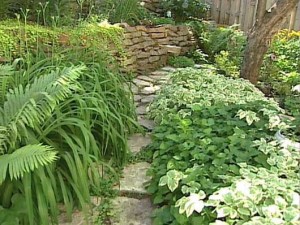 The Arts & Crafts garden is a graceful complement to the bungalow, embodying the movement’s principles of utility, economy of effort and subtle beauty. The best of these gardens are unpretentious and natural, and include gently curved beds, structures made from local materials, and food plants used as ornamentals. Bungalow gardens are meant to be lived in and enjoyed as outdoor rooms. They should require a minimum of effort but give maximum opportunity for recreation and the appreciation of nature.
The Arts & Crafts garden is a graceful complement to the bungalow, embodying the movement’s principles of utility, economy of effort and subtle beauty. The best of these gardens are unpretentious and natural, and include gently curved beds, structures made from local materials, and food plants used as ornamentals. Bungalow gardens are meant to be lived in and enjoyed as outdoor rooms. They should require a minimum of effort but give maximum opportunity for recreation and the appreciation of nature.
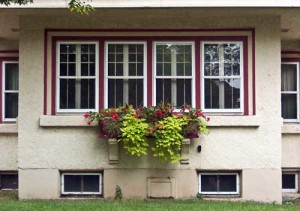 Several features can help to join the house and yard and were popular with the original bungalow dwellers. An open porch or veranda encourages outdoor living, as does a rear terrace partially enclosed with a planter or a trellis. When covered with vines, window boxes or hanging baskets, these elements become “garden” as well as architecture. The quintessential Arts & Crafts garden feature was the pergola, lauded as practical and picturesque. Here the family could sit and chat.
Several features can help to join the house and yard and were popular with the original bungalow dwellers. An open porch or veranda encourages outdoor living, as does a rear terrace partially enclosed with a planter or a trellis. When covered with vines, window boxes or hanging baskets, these elements become “garden” as well as architecture. The quintessential Arts & Crafts garden feature was the pergola, lauded as practical and picturesque. Here the family could sit and chat.
 Roses, honeysuckle, clematis, trumpet vine, Dutchman’s pipe, porcelain berry and Engleman’s ivy all can be used to make a beautiful show clambering over pergola or gate. For a quicker cover, try annual vines like morning glory, the white-blooming moonflower, balloon vine (Cardiospermum halicacabum), cypress vine (Ipomoea quamoclit) with its lacy leaves, or Black-eyed Susan vine (Thunbergia alata) with golden orange blooms.
Roses, honeysuckle, clematis, trumpet vine, Dutchman’s pipe, porcelain berry and Engleman’s ivy all can be used to make a beautiful show clambering over pergola or gate. For a quicker cover, try annual vines like morning glory, the white-blooming moonflower, balloon vine (Cardiospermum halicacabum), cypress vine (Ipomoea quamoclit) with its lacy leaves, or Black-eyed Susan vine (Thunbergia alata) with golden orange blooms.
In keeping with small yards, the first bungalow gardeners often included plants that were useful as well as attractive such as dwarf fruit trees. They used currants and blueberries as hedges or border plants and arbors and trellises to support grapes and scarlet runner beans as well as roses. Today’s gardener might try ornamental vegetables like ‘Rainbow’ chard or a handsome herb like curled parsley.
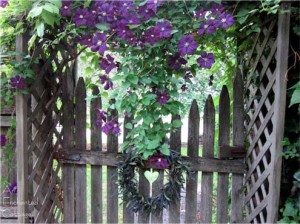 Arts & Crafts gardens should feature beautiful constructions (gates, path) to gently guide the family and visitors through the yard, plus resting spots (benches, seats) for enjoying the borders and the birds. Old-fashioned shrubs—lilacs, peonies, spirea, hydrangea and shrub roses–are at home here, as are “grandmother’s” flowers—daisies, lily-of-the-valley, columbine, lilies, bachelor’s buttons, cosmos, foxgloves, hollyhocks, malva, moss rose, zinnia and pansies. Native plantings fit both the cottager’s philosophy and garden style. Plants to try are coneflower, Joe-Pye weed, liatris, black-eyed Susan (Rudbeckia hirta), and the grasses Big and Little Bluestem.
Arts & Crafts gardens should feature beautiful constructions (gates, path) to gently guide the family and visitors through the yard, plus resting spots (benches, seats) for enjoying the borders and the birds. Old-fashioned shrubs—lilacs, peonies, spirea, hydrangea and shrub roses–are at home here, as are “grandmother’s” flowers—daisies, lily-of-the-valley, columbine, lilies, bachelor’s buttons, cosmos, foxgloves, hollyhocks, malva, moss rose, zinnia and pansies. Native plantings fit both the cottager’s philosophy and garden style. Plants to try are coneflower, Joe-Pye weed, liatris, black-eyed Susan (Rudbeckia hirta), and the grasses Big and Little Bluestem.
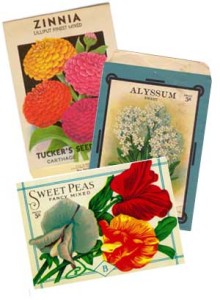 In all, remember that the house and garden should be “of a piece,” with colors and construction materials a harmonious whole.
In all, remember that the house and garden should be “of a piece,” with colors and construction materials a harmonious whole.
Other annuals: alyssum, browalia, calendulas, cornflower (Centaurea), larkspur, nasturtiums, nicotiana, petunias, sweet peas. For containers and hanging baskets: miniature morning glory, nasturtiums, Petunia integrifolia.
Other perennials: asters, balloon flower (Platycodon), bellflowers (Campanula), bleeding heart, bee balm, chrysanthemums, coreopsis, daffodils, daylilies, delphiniums, iris, lady’s mantle, lamb’s ears, lavender, lupine, phlox, primroses, salvia.
Now, here’s Amy Jensen Stonestrom’s recommendations—
 To create an authentic landscape that will complement your bungalow, take hints for plant choices from interior Arts & Crafts style accents. Since the ideology in the early 20th century was to bring the outdoors inside, much of the pottery, glassware and textiles of the period featured botanicals that were popular at the time. To achieve ultimate authenticity, you can buy heirloom seeds through mail-order catalogs that are direct descendants and genetically match the plants used in the early 1900s. However, keep in mind that new plant varieties often have better disease resistance and can offer you more choices in terms of color, size and texture. The following is a sampling of plants that were often admired and used for inspiration by the original Arts & Crafts artisans.
To create an authentic landscape that will complement your bungalow, take hints for plant choices from interior Arts & Crafts style accents. Since the ideology in the early 20th century was to bring the outdoors inside, much of the pottery, glassware and textiles of the period featured botanicals that were popular at the time. To achieve ultimate authenticity, you can buy heirloom seeds through mail-order catalogs that are direct descendants and genetically match the plants used in the early 1900s. However, keep in mind that new plant varieties often have better disease resistance and can offer you more choices in terms of color, size and texture. The following is a sampling of plants that were often admired and used for inspiration by the original Arts & Crafts artisans.
(Note: spp. is an abbreviation for “species.”)
Trees
- Cherry (Prunus spp.)
- Gingko (Gingko biloba)
- Oak (Quercus spp.)
- Pine (Pinus spp.)
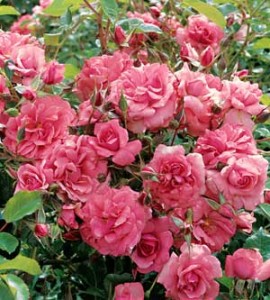 Shrubs
Shrubs
- Dogwood (Cornus spp.)
- Hydrangea (Hydrangea spp.)
- Honeysuckle (Lonicera spp.)
- Shrub Rose (Rosa rugosa)
Perennials
- Bleeding Heart (Dicentra spectabilis)
- Columbine (Aquilegia canadensis)
- Coneflower (Echinachea)
- Foxglove (Digitalis spp.)
- Hollyhock (Althea rosea)
- Peony (Paeonia spp.)
- Poppy (Papaver spp.)
- Water lily (Nymphaea spp.)
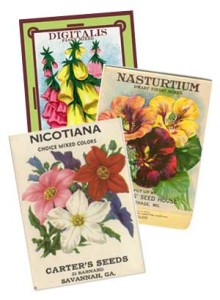 Bulbs
Bulbs
- Allium (Allium giganteum)
- Crocus (Crocus spp.)
- Daffodils (Narcissus spp.)
- Dahlia (Dahlia spp.)
- Iris (Iris spp.)
- Lily of the Valley (Convallaria majalis)
- Tulip (Tulipa spp.)
Annuals
- Acanthus (Acanthus mollis)
- Sweet Pea (Lathyrus odoratus)
- Moonflower (Ipomoea alba)
- Morning Glory (Ipomoea tricolor)
- Nasturtiums (Tropaeolum majus)
- Nicotiania (Nicotiania spp.)
- Plumed Thistle (Cirsium japonicum)
- Sunflower (Helianthus spp.)
- Verbena (Verbena spp.)
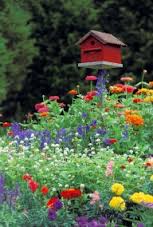 The main design element that differentiated Arts & Crafts gardens from the Victorian gardens was to keep lines less formal and less symmetrical. Planting perennials in “drifts” also became popular, meaning that the same plants were put together to produce large blocks of color and texture rather than placing them intermittently with other plants. Front-door cottage gardens came into vogue and were planted to look completely natural and untamed.
The main design element that differentiated Arts & Crafts gardens from the Victorian gardens was to keep lines less formal and less symmetrical. Planting perennials in “drifts” also became popular, meaning that the same plants were put together to produce large blocks of color and texture rather than placing them intermittently with other plants. Front-door cottage gardens came into vogue and were planted to look completely natural and untamed.
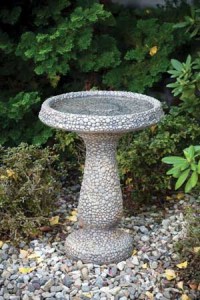 Garden objects and furniture were also used with more frequency. Pergolas, lanterns, wicker tables and chairs, copper birdbaths and feeders, large stones, cement statues, and ponds were added to landscapes to extend the living space into the outdoors. In the western United States, Japanese gardens are often used in conjunction with bungalows. Since Japanese gardens imitate a vast expanse on a miniature scale (i.e., a small pond represents a lake or the ocean), it gives the gardener a sense of having a larger yard, and because elements of the traditional bungalow were taken from Japanese architecture, the home and the garden mesh beautifully.
Garden objects and furniture were also used with more frequency. Pergolas, lanterns, wicker tables and chairs, copper birdbaths and feeders, large stones, cement statues, and ponds were added to landscapes to extend the living space into the outdoors. In the western United States, Japanese gardens are often used in conjunction with bungalows. Since Japanese gardens imitate a vast expanse on a miniature scale (i.e., a small pond represents a lake or the ocean), it gives the gardener a sense of having a larger yard, and because elements of the traditional bungalow were taken from Japanese architecture, the home and the garden mesh beautifully.









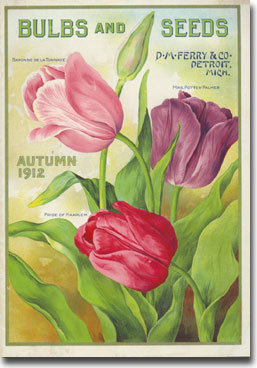 Q: I’ve finally got my bungalow in shape and am ready to tackle the yard this spring. I want to make sure my garden is appropriate, though. What are some of the flowers and plants recommended for the bungalow period? What were the key design elements for small urban gardens?
Q: I’ve finally got my bungalow in shape and am ready to tackle the yard this spring. I want to make sure my garden is appropriate, though. What are some of the flowers and plants recommended for the bungalow period? What were the key design elements for small urban gardens?

